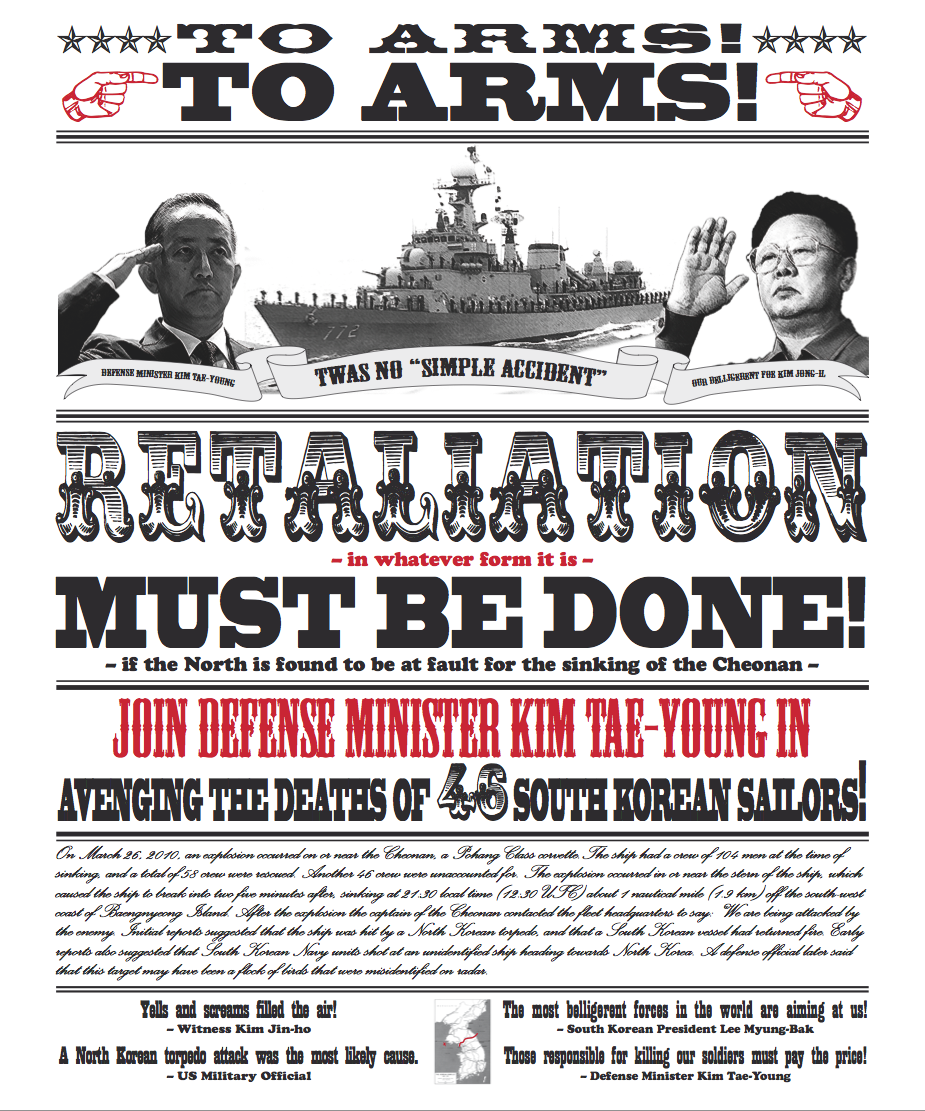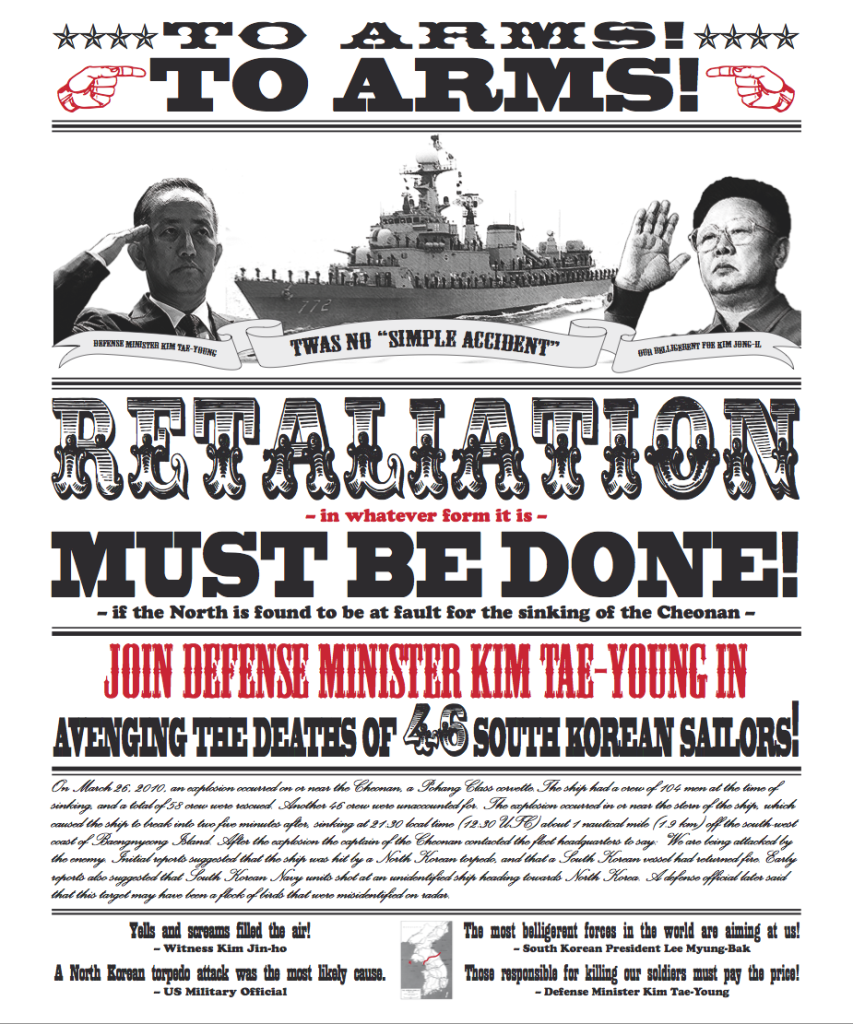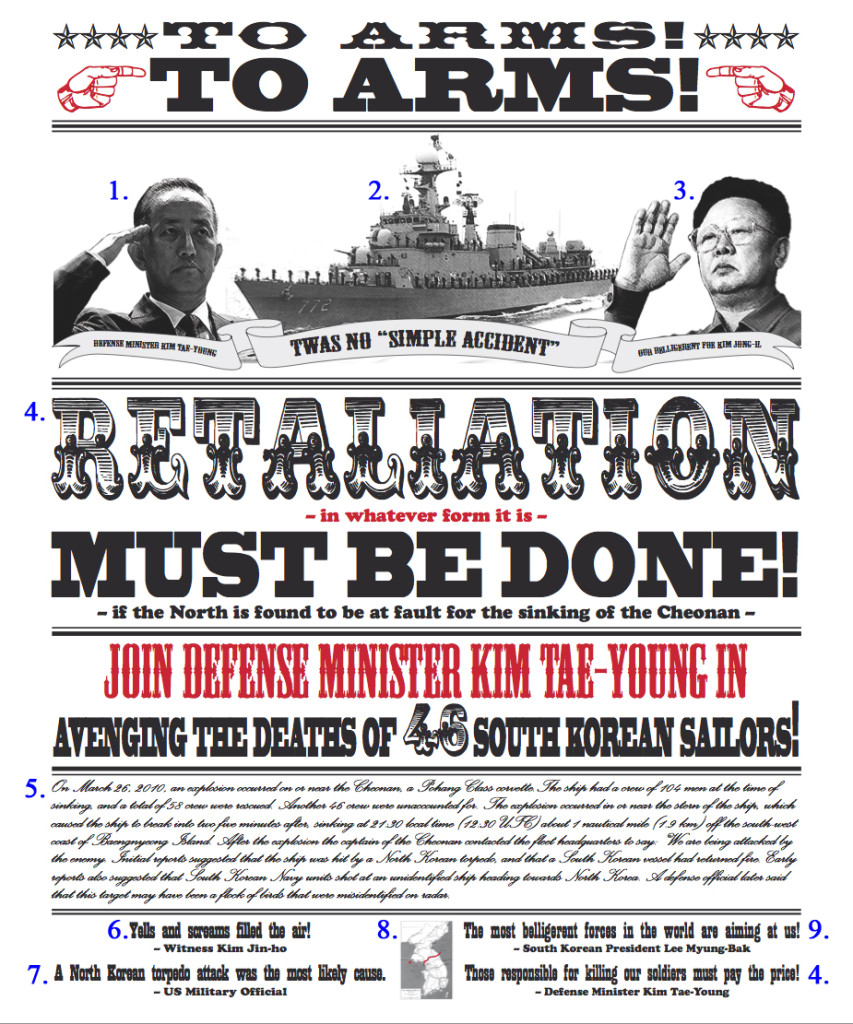A Modern Civil War Poster for South Korea’s Cheonan Warship Sinking
This post explores the history of INDUSTRIAL SOCIETY (1830-1944), Victorian Design (1840-1900), and Civil War Posters (1861-1865) in order to create a modern representation of a Civil War poster, based on the sinking of the South Korean warship – the Cheonan – on March 26, 2010.
Click here for a large image of the full poster from my Tumblr blog.
The following is the actual text of the script on the poster, describing the Cheonan incident, retrieved from Wikipedia on May 10, 2010 from http://en.wikipedia.org/wiki/ROKS_Cheonan_(PCC-772). Since then, the story on Wikipedia has changed, removing all information about the “early reports” from the incident:
On March 26, 2010, an explosion occurred on or near the Cheonan, a Pohang Class corvette.The ship had a crew of 104 men at the time of sinking, and a total of 58 crew were rescued. Another 46 crew were unaccounted for. The explosion occurred in or near the stern of the ship, which caused the ship to break into two five minutes after, sinking at 21:30 local time (12:30 UTC) about 1 nautical mile (1.9 km) off the south-west coast of Baengnyeong Island. After the explosion the captain of the Cheonan contacted the fleet headquarters to say: “We are being attacked by the enemy.” Initial reports suggested that the ship was hit by a North Korean torpedo, and that a South Korean vessel had returned fire. Early reports also suggested that South Korean Navy units shot at an unidentified ship heading towards North Korea. A defense official later said that this target may have been a flock of birds that were misidentified on radar.
The Purpose of the Poster
My goal with this poster design is to not only relate it to US Civil War posters, but also to depict the current mood surrounding this issue, and show the very emotional responses that some in upper-levels of the government and media have been giving (at least in Korea – though I heard Mrs. Clinton also recently took a very hard stance against North Korea). I want it to be clear that emotional responses, and angry retaliation without thinking through the consequences of what one says, or what one prints, should not be taken lightly, or acted upon rashly. War should never be a first response, or even a first consideration to any action, apart from an act of war itself. Since the sinking of the Cheonan in March, North Korea has denied all involvement in the incident (something, it seems, no one in the international community takes seriously), and has not responded or advanced militarily.
These recent events have led the only divided country in the world into a tense “Cold War-like” state in which both are clearly upset at and fear the other, but neither wants to be the initiator of a certainly costly war. However, I still find the US Civil War to be an equally adequate reflection of the present state of affairs in Korea. The country is still technically at war, divided North and South for the past 50+ years, and the recent events could easily have led to (and may still lead to) a declaration of war (again), and recruitment poster. Therefore, led me outline the process of research and planning I went through to create this modern day Civil War poster for South Korea.
Media Design of the Industrial Society (1830-1944)
In Design Management, Kathryn Best shows a timeline of design that put the Industrial Society (1830-1944) at the beginning of modern design. I chose to look closely at the Victorian Era of design (1840-1900), with Civil War posters (1861-1865) being my main focus for designing this poster. Although many of the “societal, cultural, or technological influences on design” (Best, 2006, p 20) shown on the timelines in Design Management are not directly print related, the fact is that much of that period’s industry played a huge part in shaping media design.
For example, although invented nearly half a century earlier, the lithographic process “[made] creation of the poster…feasible.” (Wikipedia, “History of graphic design”). Lithography allowed for images to be printed based on the simple fact that oil and water don’t mix.1 Lithography’s inventor, Alois Senefelder introduced color lithography – chromolithography – in 1818 in his book A Complete Course of Lithography, which used the same principles, and multiple lithography stones to create color images. Wikipedia states that, “the first American chromolithograph…was created by William Sharp in 1840… They were prominent after the Civil War because of their low production costs and ability to be mass produced, and because the methods allowed pictures to look more like hand-painted oil paintings.” (Wikipedia, “Chromolithography”). My research browsing through old Civil War posters confirmed that although a handful of them contained color images,2 most did not.3
Additionally, the steam-powered rotary press was invented in 1847 by Richard March Hoe and replaced the old hand-operated Gutenberg-style press. This allowed for “printing on an industrial scale, [and] Western-style printing was adopted all over the world, becoming practically the sole medium for modern bulk printing.” (Wikipedia, “Printing Press”). William Bullock then improved upon the rotary press significantly in 1863 with the invention of his web rotary press, which initially printed 12,000 sheets per hour, and was later improved to print 30,000 sheets per hour. (Wikipedia, “History of Printing”, “William Bullock (inventor)”). These improvements to the printing press would have allowed a large number of posters to be made in a short time – perfect for the recruitment of soldiers.
Typographically, Wikipedia says that “the most notable invention [of the 19th century] was the rise of typefaces with strengthened serifs… In fact slab-serif fonts ([such as] Clarendon from 1845) were newspaper fonts, whose serifs were strengthened in order to prevent damage during the printing process.” (Wikipedia, “History of Western Typography”). My own research confirmed this statement, as I found strengthened serif fonts, slab-serif fonts, and very bold, thick typography were present on nearly every old Civil War poster.
Furthermore, most posters contained “Wild West” fonts – similar to those found on “Wanted” posters during that time period. “Crude as they were one could not escape reading the large, bold type that announced a REWARD or proclaimed an individual WANTED…The Old West was a time of expansion and unbridled individualism…The Westward movement occurred at a rapid rate spurred on by the gold rush, land grants and other incentives that stirred the imagination of many who lived in poverty and neglect. Thoughts of easy wealth and an open and unprotected frontier [were] often too tempting.” (Ichiyama, “How Wood Type Tamed the West”). Indeed, Western expansion and romanticized notions about cowboys, gold, guns, and an open frontier contributed much to the style of wood and metal type printing of that period. The “Wanted” poster for Abraham Lincoln’s assassins is a perfect example of this style of bold, Western typography.4
Stylistic Traditions of the Victorian Era (1840-1900)
Looking more closely at the Victorian Era, which encompassed the American Civil War, reveals additional characteristics as to the styles and ideals of the time. Parkland College’s website tells us (and demonstrates through multiple examples), “the Victorian Era was a time of strong moral and religious beliefs.” Additionally, the Victorian era brought a love for “ornate complexity and fussiness” in all areas of design, and was heavily influenced by nostalgia for objects of the past – earlier designs from England – like type in cloth banners, ornamental typography (often drawn on a curve), symmetrical layouts, and images framed within decorative borders – often architectural motifs. Although not all of these things made their way into Civil War poster design, their influence is apparent. Most notably are the ornamental Western fonts, and the fact that Victorian design and Civil War posters both try to “fill every corner of the entire page with type and pictures.” (Young, “The Victorian Era”).
Investigation of Civil War Poster styles (1861-1865)
My own investigation into various Civil War posters revealed many similarities among them. Each line of text on a poster had a different font style and often used different font faces entirely. Sometimes very similar fonts were used that were either very stretched and tall, or very squashed, depending on the importance of the words their placement on the poster. Bold type at the top caught the eye, and was often followed by a more thorough description of details in smaller type toward the bottom of the poster. Nearly all the fonts were serif fonts, very bold and blocky, many with Western embellishments, although a few used some script fonts (particularly more modern recreations of Civil War posters5), and the text generally took up the full width of the poster. Writing on the posters was usually very formal, with full dates being written out in text, not numbers, and the posters were very informative. Additionally, the language used on posters was very strong – a language of urgency, immediacy, and strong moral principles.
Images were minimal on the posters as text took up the majority of the space, but an eagle, American flag, and type in a cloth banner declaring the “unity of the Union!” were common elements. Additionally, nearly every poster contained at least one image of a finger pointing at the most important line of text. The images look hand-drawn, and probably were drawn onto a lithography stone for bulk printing. Everything was usually symmetrical, and every corner of the poster was filled with something. Some posters incorporated ornamental borders, but nearly every one used different weights of dividing lines to separate certain blocks of text from each other. The different weights of dividing lines – thin-thick, thick-thin, thin-think-thin, and so on – are as varied as the font faces used in design.
The Cheonan Poster Design
I chose to design a poster for Korea, based on the recent sinking of their Cheonan warship, because I live here and hear many things about this story from various news sources. I think it is interesting that over fifty years after the Korean War, the two countries – North and South – are still technically at war with each other. Therefore, taking this recent event that pits North versus South, and basing my design on Civil War posters seemed like the perfect fit.
In my poster design, I sought to follow a few basic principles I noticed during my research. First and most importantly, is my choice of multiple Western style fonts, large and small, stretched and squashed to bring out the important points of the “call to arms.” I tried to emulate the same urgency, immediacy and strong language of morality that I saw often used in Civil War designs. I emphasized the important words and toned down the parts that wouldn’t help the poster’s message (for example, “if the North is found to be at fault…”). I chose to use a script font for the lengthy description of events toward the bottom of the poster, and used a more ornamental (not Western) font for the main word “Retaliation” to emulate more of the Victorian style of ornamental type usage. I used fingers to point out the important message of the poster, and different weights of dividing lines to break up the text into appropriate sections. I also drew a cloth banner and put text (with a little curve) onto it, and I used Photoshop filters to mimic the look of hand-drawn black and white pictures on the old posters. Additionally, nearly all of the text I used is directly quoted from various sources.6
Military Retaliation is Not the Answer
Finally, although I don’t condone retaliation against the North, I do feel that this poster does a good job of expressing the sentiment of many South Koreans, as well as reflecting the style and feeling of American Civil War posters.
Additionally, given the escalation of news stories from both South Korea and the USA in recent weeks, I want this poster to express the seriousness of a call to arms against North Korea. As many have said – and it is true – something must be done. But military retaliation is not the right course of action, and I seriously hope that both Presidents in Korea and the US realize that before making any rash judgments that could seriously impact the entire Eastern part of the world.
What about You?
What do you think about the sinking of the Cheonan? What should be done about North Korea?
End Notes
1. Basically, a design is drawn in oily ink on a limestone slab and affixed to the stone with an acid wash. Water is washed over the stone, being repelled from the design lines, and oily printers ink is then washed over that – being repelled from the water into the design. The whole thing (with paper) is then run through a press and an image is produced. (Masterworks Fine Art, “Lithograph”).
2. Color poster
3. The majority of posters weren’t in color.
4. Lincoln’s Murder’s Wanted Poster
5. A recreation of a Civil War Poster for a publication
6. On my Cheonan poster design
- Kim Tae-Young picture: http://www.zimbio.com/pictures/qYDDyIkS4cZ/South+Korean+Holds+Inauguration+Ceremony+New/xZcRrA5Hxnj/Kim+Tae-Young
- Cheonan picture (ID number modified to 772, the Cheonan’s number – original picture is 961): http://www.defenseindustrydaily.com/images/SHIP_FF961_ROKS_Chongju_Ulsan_Late_Class_lg.jpg
- Kim Jong-Il picture: http://www.prisonplanet.com/how-george-bush-gave-krazy-kim-the-bomb.html
- S Korea vows retaliation for ‘Cheonan’. (2010, May 2). Press TV. Retrieved May 10, 2010 from http://www.presstv.ir/detail.aspx?id=125161§ionid=351020405
- ROKS Cheonan (PCC-772). (n.d.). In Wikipedia. Retrieved May 10, 2010 from http://en.wikipedia.org/wiki/ROKS_Cheonan_(PCC-772)
- The Associated Press. (2010, March 27). Rescuers search for sunken S. Korea ship’s crew. MSNBC. Retrieved May 10, 2010 from http://www.msnbc.msn.com/id/36052055/
- Kim, Myong Chol. (2010, May 5). Pyongyang sees US role in Cheonan sinking. Asia Times. Retrieved May 10, 2010 from http://www.atimes.com/atimes/Korea/LE05Dg01.html
- Old map of Korea: http://www.history.army.mil/books/amh/Map25-45.jpg
- Kim, Hyung-jin. (2010, May 3). Lee: Warship sinking was no ‘simple accident’. The Seattle Times. Retrieved May 10, 2010 from http://seattletimes.nwsource.com/html/nationworld/2011771664_apasskoreashipsinks.html
Paper References
- Best, Kathryn. (2006). Design Management. Switzerland: AVA Publishing SA.
- Chromolithography. (n.d.). In Wikipedia. Retrieved May 14, 2010 from http://en.wikipedia.org/wiki/Chromolithography
- History of Graphic Design. (n.d.). In Wikipedia. Retrieved May 14, 2010 from http://en.wikipedia.org/wiki/History_of_graphic_design#Placards_and_posters
- History of Printing. (n.d.). In Wikipedia. Retrieved May 14, 2010 from http://en.wikipedia.org/wiki/History_of_printing
- History of Western Typography. (n.d.). In Wikipedia. Retrieved May 14, 2010 from http://en.wikipedia.org/wiki/History_of_western_typography
- Ichiyama, Dennis. (2004). How Wood Type Tamed the West. On the St. Bride website. Retrieved May 14, 2010 from http://stbride.org/friends/conference/badtype/wood-type.html
- Masterworks Fine Art. (2009). Lithograph. On the Masterworks Fine Art website. Retrieved May 14, 2010 from http://www.masterworksfineart.com/art/printmaking.html#2
- Printing Press. (n.d.). In Wikipedia. Retrieved May 14, 2010 from http://en.wikipedia.org/wiki/Printing_press#cite_note-meggs147-48
- William Bullock (inventor). (n.d.). In Wikipedia. Retrieved May 14, 2010 from http://en.wikipedia.org/wiki/William_Bullock_(inventor)
- Young, Paul (webmaster). (2009, May 18). The Victorian Age. On the Parkland College website. Retrieved May 5, 2010 from http://gds.parkland.edu/gds/!lectures/history/1840/victorian.html









Hello, I think your website might be having browser compatibility issues.
When I look at your blog in Opera, it looks fine but when opening in Internet Explorer, it has
some overlapping. I just wanted to give you a quick heads up!
Other then that, very good blog!
Yes, please refrain from viewing in Internet Explorer. That browser uses old code to render web pages and is incompatible with most modern websites. In fact, developers often have to “hack” their website’s code to make it look OK in IE. It’s a huge pain, and quite time consuming. I’m looking forward to the day when IE is just a painful memory.